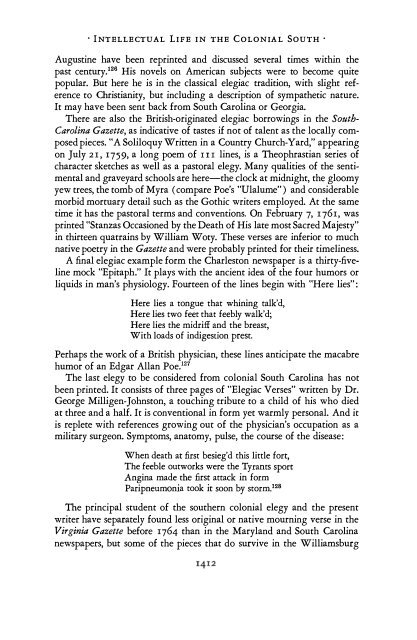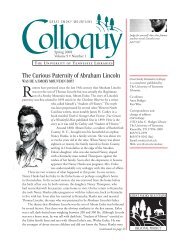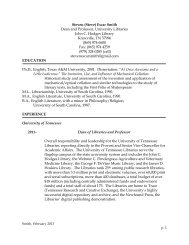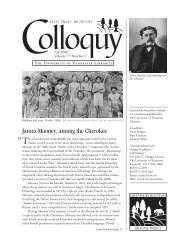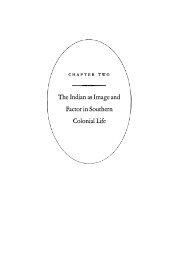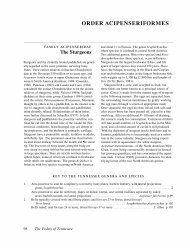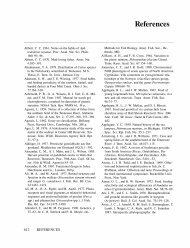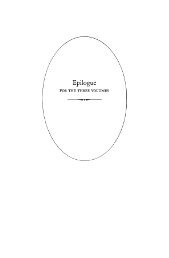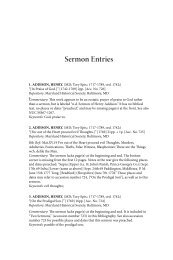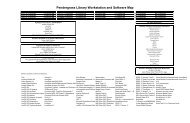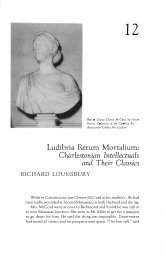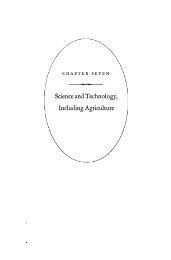Literature, Principally Belletristic - University of Tennessee, Knoxville
Literature, Principally Belletristic - University of Tennessee, Knoxville
Literature, Principally Belletristic - University of Tennessee, Knoxville
Create successful ePaper yourself
Turn your PDF publications into a flip-book with our unique Google optimized e-Paper software.
• INTELLECTUAL LIFE IN THE COLONIAL SOUTH '<br />
Augustine have been reprinted and discussed several times within the<br />
past century.126 His novels on American subjects were to become quite<br />
popular. But here he is in the classical elegiac tradition, with slight reference<br />
to Christianity, but including a description <strong>of</strong> sympathetic nature.<br />
It may have been sent back from South Carolina or Georgia.<br />
There are also the British-originated elegiac borrowings in the South<br />
Carolina Gazette, as indicative <strong>of</strong> tastes if not <strong>of</strong> talent as the locally composed<br />
pieces. "A Soliloquy Written in a Country Church-Yard," appearing<br />
on July 21, 1759, a long poem <strong>of</strong> III lines, is a Theophrastian series <strong>of</strong><br />
character sketches as well as a pastoral elegy. Many qualities <strong>of</strong> the sentimental<br />
and graveyard schools are here-the clock at midnight, the gloomy<br />
yew trees, the tomb <strong>of</strong> Myra (compare Poe's "Ulalume" ) and considerable<br />
morbid mortuary detail such as the Gothic writers employed. At the same<br />
time it has the pastoral terms and conventions. On February 7, 1761, was<br />
printed "Stanzas Occasioned by the Death <strong>of</strong> His late most Sacred Majesty"<br />
in thirteen quatrains by William Woty. These verses are inferior to much<br />
native poetry in the Gazette and were probably printed for their timeliness.<br />
A final elegiac example form the Charleston newspaper is a thirty-fiveline<br />
mock "Epitaph." It plays with the ancient idea <strong>of</strong> the four humors or<br />
liquids in man's physiology. Fourteen <strong>of</strong> the lines begin with "Here lies" :<br />
Here lies a tongue that whining talk'd,<br />
Here lies two feet that feebly walk'd;<br />
Here lies the midriff and the breast,<br />
With loads <strong>of</strong> indigestion prest.<br />
Perhaps the work <strong>of</strong> a British physician, these lines anticipate the macabre<br />
humor <strong>of</strong> an Edgar Allan Poe.127<br />
The last elegy to be considered from colonial South Carolina has not<br />
been printed. It consists <strong>of</strong> three pages <strong>of</strong> "Elegiac Verses" written by Dr.<br />
George Milligen-Johnston, a touching tribute to a child <strong>of</strong> his who died<br />
at three and a half. It is conventional in form yet warmly personal. And it<br />
is replete with references growing out <strong>of</strong> the physician's occupation as a<br />
military surgeon. Symptoms, anatomy, pulse, the course <strong>of</strong> the disease:<br />
When death at first besieg'd this little fort,<br />
The feeble outworks were the Tyrants sport<br />
Angina made the first attack in form<br />
Paripneumonia took it soon by storm.128<br />
The principal student <strong>of</strong> the southern colonial elegy and the present<br />
writer have separately found less original or native mourning verse in the<br />
Virginia Gazette before 1764 than in the Maryland and South Carolina<br />
newspapers, but some <strong>of</strong> the pieces that do survive in the Williamsburg


